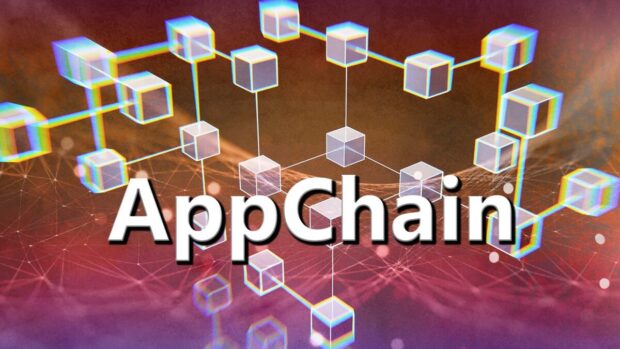Since the advent of Bitcoin, the blockchain landscape has undergone significant evolution, transitioning from single-use case cryptocurrencies to complex decentralized applications (DApps). Amid this evolution, a new technological frontier has emerged: Appchains. These application-specific blockchains offer a tailored environment for DApps, promising a leap in scalability and efficiency. As we delve into the intricacies of Appchains, we uncover their pivotal role in the ongoing decentralization saga, reshaping the way developers and businesses approach blockchain solutions.
What Are Appchains?

Appchains, short for application-specific blockchains, are customized networks designed to support specific applications or ecosystems. Unlike traditional Layer 1 (L1) blockchains like Ethereum, which are generalized platforms for various applications, Appchains provide a dedicated environment, ensuring optimized performance and greater flexibility. They bridge the gap between the one-size-fits-all nature of L1s and the specific needs of individual applications, offering a middle ground between universality and specificity. This specialization allows for enhanced scalability, security, and efficiency, as each Appchain can be tailored to its application’s unique requirements, avoiding the congestion and competition for resources inherent in L1 networks.
The Role of Appchains in Decentralized Applications (DApps)
In the realm of DApps, Appchains serve as the backbone, providing a specialized and efficient platform tailored to the application’s needs. This specificity facilitates higher throughput and lower transaction costs compared to general-purpose blockchains. Appchains enhance user experience by ensuring that applications are not bogged down by the broader network’s traffic and limitations. They allow for the creation of customized governance models, security protocols, and economic structures, which are pivotal for DApps demanding unique functionalities and performance metrics. As Appchains are designed around their respective DApps, they offer a more seamless and integrated user experience, fostering greater adoption and satisfaction.
Appchains vs Smart Contracts: A Comparative Analysis

While both Appchains and smart contracts are instrumental in the development of DApps, they serve different purposes and operate at different layers of the blockchain ecosystem. Smart contracts are self-executing contracts with the terms of the agreement directly written into code, running on general-purpose blockchains like Ethereum. They are the building blocks for DApps, providing the logic and functionalities needed for decentralized operations.
On the other hand, Appchains are entire blockchain networks designed specifically for a single application or a set of related functionalities. Unlike smart contracts, which are limited by the capabilities and constraints of the underlying L1 blockchain, Appchains offer full control over the blockchain environment, including consensus mechanisms, governance models, and performance parameters. This control translates into greater scalability, customizability, and independence from the congested networks of L1 blockchains.
The choice between using a smart contract and developing an Appchain depends on the specific needs of the application. For simpler applications with standard requirements, smart contracts on established L1 blockchains may suffice. However, for more complex and resource-intensive applications or those requiring a high degree of customization and control, an Appchain could provide a more suitable and efficient solution.
Impact of Appchains on Blockchain Scalability

Scalability remains one of the most significant challenges facing the blockchain industry today. While foundational, traditional monolithic (Layer 1) architectures often struggle with bottlenecks as they scale, primarily due to the need to maintain consensus across a wide network. Enter Appchains: by providing application-specific environments, they inherently divide the broader blockchain’s workload into manageable, isolated segments. This division allows each Appchain to process transactions and operations independently, significantly reducing the load on any single network and enhancing overall transaction throughput.
Moreover, Appchains embody the principle of modular architecture—each serves a distinct purpose and can scale independently. This modularity is key to addressing the blockchain trilemma by balancing decentralization with scalability and security. For example, networks like Cosmos and Polkadot utilize app-specific chains (Cosmos Zones and Parachains, respectively) to improve scalability without compromising the network’s integrity or its decentralized nature. By enabling parallel processing, Appchains can significantly increase the capacity of the ecosystem to handle transactions and smart contract executions, paving the way for broader adoption and more complex applications in the blockchain space.
Challenges and Considerations in Implementing Appchains
Despite their potential, appchains are not without challenges. One of the primary hurdles is the complexity involved in their creation and maintenance. Developing a dedicated blockchain requires substantial resources, expertise, and time, which can be a significant barrier for smaller teams or projects with limited budgets. Moreover, while Appchains can inherit security features from their parent chains, ensuring the robustness of these security measures remains a critical concern. The relatively isolated nature of appchains might lead to vulnerabilities if not properly managed and secured.
Interoperability is another consideration. As the blockchain ecosystem grows increasingly fragmented with numerous Appchains, ensuring these chains can communicate and transact with one another becomes paramount. Projects like Cosmos and Polkadot are spearheading solutions to this issue, but widespread interoperability is still a work in progress. Additionally, user adoption can be a challenge, as moving users from established platforms to new, app-specific chains requires overcoming inertia and trust barriers.
Lastly, regulatory considerations cannot be ignored. As Appchains can operate across jurisdictions, ensuring compliance with varying regulations can be complex. Developers must navigate the legal landscape carefully to avoid pitfalls that could threaten the project’s viability.
Future Prospects of Appchains in Decentralization

The future of appchains in the blockchain ecosystem appears promising, as they offer a viable solution to longstanding issues of scalability, efficiency, and customizability. As these chains mature, we can expect to see a more diverse and dynamic environment, with each Appchain tailored to specific needs, driving innovation and adoption across sectors.
The growing emphasis on decentralized finance (DeFi), non-fungible tokens (NFTs), and other blockchain applications will likely fuel the development and proliferation of Appchains. As technology evolves, we may witness the emergence of standard frameworks and tools that simplify the creation and deployment of Appchains, making them more accessible to a broader range of developers and projects.
Moreover, the advancement in interoperability protocols will play a critical role in integrating Appchains into the broader blockchain ecosystem, enabling seamless exchanges of information and value. This interconnectedness will be crucial in realizing the full potential of decentralization, as it allows for a more collaborative and efficient system free from the silos of traditional centralized infrastructures.
Conclusion
Appchains represent a significant step forward in the evolution of blockchain technology. They offer a path towards a more sustainable and versatile blockchain ecosystem by addressing critical issues like scalability, customizability, and efficiency. While challenges such as complexity, security, and interoperability remain, the continuous advancements suggest a promising future for Appchains.
In the context of Appchains and their promise for a more decentralized, efficient blockchain ecosystem, the role of smart contract auditing emerges as a critical facet. As these application-specific blockchains empower developers with greater control and customization over their decentralized applications (DApps), the importance of ensuring the security and reliability of these platforms cannot be overstated. Smart contract audits, in this light, become indispensable.
As the blockchain community continues to explore and refine these solutions, we stand on the brink of a new era in decentralization—one where Appchains play a central role in shaping the landscape of digital interactions, finance, and beyond. Their potential to drive innovation and inclusivity in blockchain applications is immense, marking a pivotal shift in our approach to decentralized systems and the vast opportunities they present.



